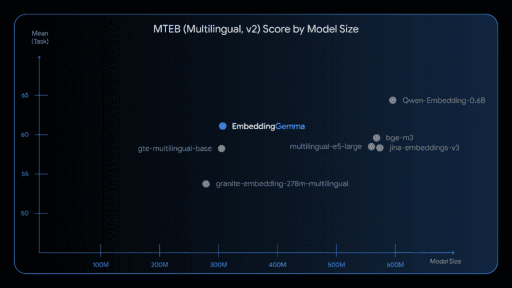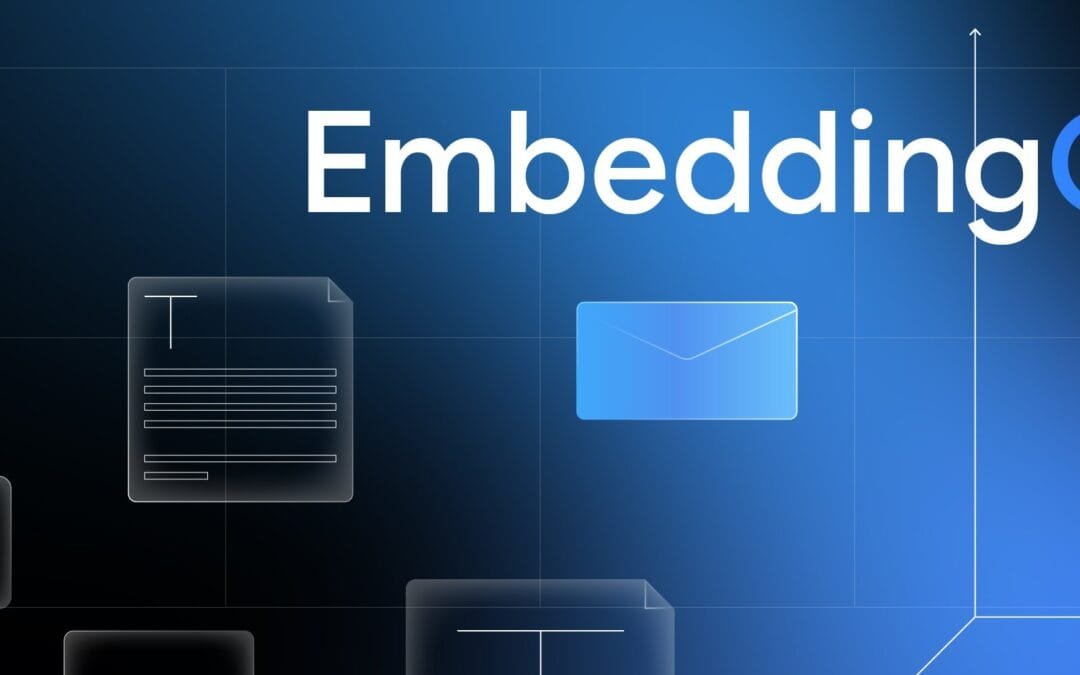EmbeddingGemma is a breakthrough in embedding models: a compact, multilingual system designed to run on-device, offline, and with minimal resource demands. Drawing from Google’s Gemma family, it delivers high-quality text representations even on phones, tablets, or laptops. With just 308 million parameters and support for over 100 languages, it combines performance, flexibility, and privacy in a single tool, making it ideal for retrieval, semantic search, and local AI systems. (ai.google.dev)
1. What is EmbeddingGemma?
EmbeddingGemma is a 308 million-parameter multilingual text embedding model developed by Google / DeepMind. (Google Developers Blog) It produces dense vector representations of text, usable for tasks like semantic search, classification, clustering, and retrieval. (Google AI for Developers)
Google designed it for on-device and offline use. It runs efficiently under constrained hardware budgets (e.g. phones, laptops), with quantization and model engineering to reduce memory and latency. (Google Developers Blog)
2. How does EmbeddingGemma compare to existing embedding models?
EmbeddingGemma competes strongly even against models double its size. In the Massive Text Embedding Benchmark (MTEB), it ranks as the top open multilingual model under 500 million parameters. (Venturebeat) The authors show it outperforms prior lightweight embedding models in retrieval, classification, clustering tasks. (arXiv)
It trades off some absolute top-tier performance (that huge models retain) for much better resource efficiency. But for many real-world tasks (especially where deployment cost or latency matter), its performance per cost is compelling. (arXiv)
Because of Matryoshka Representation Learning (MRL), one model supports multiple embedding output sizes (768 → 512 → 256 → 128 dims) with minimal performance degradation. (Google Developers Blog) That lets developers choose trade-offs between speed, memory, and accuracy.
In contrast, many existing embedding models fix a single embedding dimension and often require more resources (RAM, compute) to achieve similar scores.
3. Is EmbeddingGemma open-source or proprietary?
EmbeddingGemma is open weights under a permissive license for “responsible commercial use.” (Google AI for Developers) Google hosts the model on Hugging Face, Kaggle, and Vertex AI. (Google Developers Blog) The model card states it’s licensed under Apache 2.0 (or similar) for general integration and fine-tuning. (Google AI for Developers)
Thus, developers can load, deploy, and fine-tune it in their own systems without paying licensing fees (within permitted usage). (Google AI for Developers)
4. When will EmbeddingGemma be available to developers?
It’s already available as of late 2025. The official Google Developer Blog announced it publicly. (Google Developers Blog) Google’s AI documentation lists it ready for deployment and inference. (Google AI for Developers) The model is accessible via Hugging Face, Vertex AI, Kaggle, and via integration in AI/ML frameworks. (Google Developers Blog)
Developers can get started now, using provided quickstart guides, code samples, and inference notebooks. (Google Developers Blog)
5. What tasks can EmbeddingGemma be used for (e.g. search, recommendation)?
EmbeddingGemma supports several common embedding-based tasks:
- Semantic search / retrieval: embed queries and documents to compute similarity. (Google AI for Developers)
- Clustering / grouping: embed sets of texts or documents and cluster in vector space. (arXiv)
- Classification / ranking: use embeddings as features for classifiers or rerankers. (arXiv)
- Retrieval-Augmented Generation (RAG): embed knowledge/document chunks locally, retrieve based on queries, feed to generation models. (Google Developers Blog)
- Domain fine-tuning: adapt to domain-specific embeddings for particular tasks (e.g. medical, legal). (Hugging Face)
Because it supports offline inference, it is suitable for building local agents (e.g. apps that work without internet) that depend on semantic matching. (Google Developers Blog)
6. Does EmbeddingGemma support cross-lingual or multilingual embeddings?
Yes. EmbeddingGemma is trained on over 100 languages and supports multilingual embedding tasks. (Google AI for Developers) It handles cross-lingual retrieval well, thanks to its training and architecture. (Google Developers Blog)
Thus, you can embed text in one language and retrieve relevant texts in another language (to a good degree), making it useful for global or multilingual systems.
7. How does Google integrate EmbeddingGemma into Search / AI?
Google positions EmbeddingGemma primarily for on-device and privacy-sensitive use cases. (Google Developers Blog) For large-scale server tasks, Google suggests using their Gemini Embedding model via API instead. (Google Developers Blog) EmbeddingGemma integrates with the broader Gemma / Gemma 3 ecosystem, sharing tokenizer compatibility to streamline hybrid pipelines. (Google Developers Blog)
In internal products or experiments, Google may use it in parts of the pipeline (e.g. embedding user text for personalization), though public confirmation is limited. The blog suggests it will power “first-party AI features” on Android or devices. (Google Developers Blog)
Because it works offline, it can let Google (or third parties) embed user data locally without sending to cloud, a privacy improvement. (Google Developers Blog)
8. What training data or architecture underlies EmbeddingGemma?
Architecture
EmbeddingGemma builds on a transformer encoder architecture derived from the Gemma 3 family. (arXiv) It uses full (bidirectional) self-attention rather than causal decoder style, which suits embedding tasks. (Hugging Face) It supports sequence lengths up to 2,048 tokens. (Google AI for Developers)
The embedding dimension is 768, but thanks to Matryoshka Representation Learning (MRL), you can truncate down to 512 / 256 / 128 with little loss. (Google Developers Blog) Quantization-aware training helps reduce memory footprint and preserve performance under quantized weights. (Google Developers Blog)
They also use geometric embedding distillation, checkpoint merging, and spread-out regularizers to improve robustness and generalization. (arXiv)
Training data
The model is trained on a massive multilingual corpus spanning over 100 languages. (Google AI for Developers) The authors report combining large web data, multilingual corpora, and distilled signal from larger models (encoder-decoder initialization) to transfer knowledge. (arXiv)
They also perform ablation studies to show which design choices matter (e.g. quantization, truncation, distillation, regularization). (arXiv) The result is that performance degrades gracefully even under truncation or quantization, a sign of robustness. (arXiv)
9. Are there benchmarks showing EmbeddingGemma’s performance?

Yes. The core benchmark is MTEB (Massive Text Embedding Benchmark), which covers retrieval, clustering, classification across many datasets and languages. (arXiv) In those results, EmbeddingGemma achieves state-of-the-art performance for models under 500M parameters, often outpacing older models with many more parameters. (arXiv)
Its performance remains strong even when embedding truncation or quantization is applied, the drop is limited. (arXiv) VentureBeat reports it “ranks highest under 500M” in MTEB multilingual v2. (Venturebeat)
Because MTEB is a well respected benchmark in the embedding community, this gives credibility to EmbeddingGemma’s claims. (arXiv)
10. Will EmbeddingGemma replace existing embedding models like BERT, CLIP, etc.?
No, but it may displace or complement many models in settings where resource efficiency, latency, or on-device constraints matter.
For heavyweight server-based pipelines where maximum performance is paramount, large models (like those behind BERT, CLIP, or massive embedding models) will still hold advantage in absolute accuracy or specialized domains.
However, EmbeddingGemma might become the default choice in many practical applications, mobile apps, edge devices, privacy-first systems, where full server pipelines aren’t feasible or are costly. Its flexibility (via embedding truncation) means developers can pick trade-offs per scenario.
In domains requiring very long contexts, extremely niche domains, or extreme precision, some bigger models may still retain an edge. But for many real-world embedding use cases, EmbeddingGemma may offer the best cost-benefit ratio.
Conclusion
Now, before you think this is some massive program that’s gonna melt your laptop, it’s actually pretty efficient. The thing’s got about 308 million parameters… yeah, that’s a big number, but for AI models, that’s like saying your truck gets “decent mileage for a pickup.” It’s also built to be quantized (that’s geek-speak for “compressed without killing the quality”), so it only takes up around 200 MB of memory. That’s small enough to run on a phone or one of those little Raspberry Pi gadgets.
Bottom line? You can build your own private, offline semantic search, like a smart little brain that organizes and finds your stuff, without paying monthly rent to Big Tech or worrying about who’s reading your data. It’s local, it’s cheap, and it’s yours.
Now, if only the cable company worked that way.

